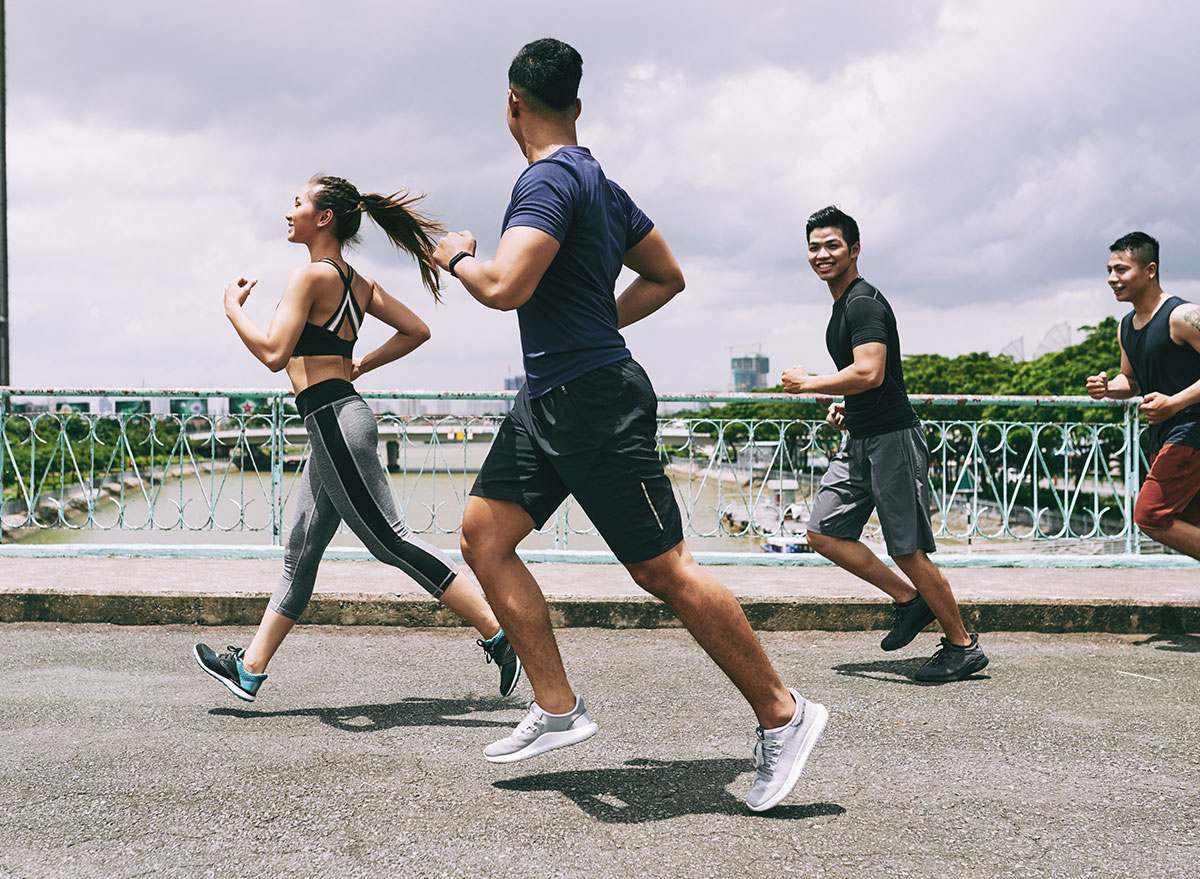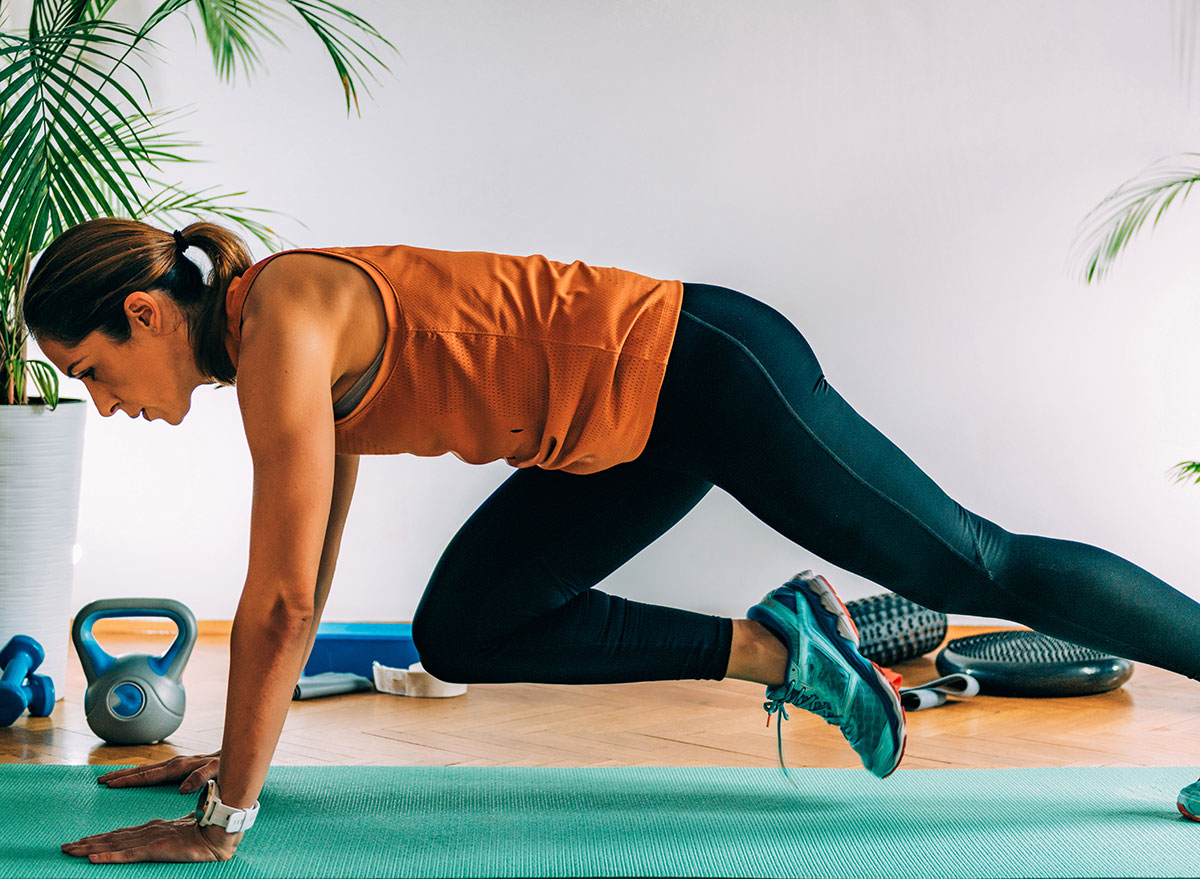5 Major Secrets to Getting a Lean Body for Good, According to Experts

Personal fitness is a marathon, not a sprint. Sure, a short-term workout plan may produce short-term benefits, but there’s a very good chance you’ll see all that progress go poof if you don’t stick to a steady routine. Many people blame time constraints for their lack of exercise consistency, but is that really a good excuse?
The truth is, you really don’t need all that much time to meaningfully accomplish some exercise. In fact, a new study just published in the American Journal of Physiology-Endocrinology and Metabolism reports all it takes is just three minutes of movement for every half hour spent sitting to help offset the effects of a sedentary lifestyle. Subjects who followed this strategy showed notable improvements in bad cholesterol and daily blood sugar stability.
Now, while moving for just three minutes every half hour almost certainly represents the bare minimum approach to exercise, many trainers believe mini-workouts are a great way to slowly start that fitness marathon toward a leaner body. Stephanie Mansour, CPT and CEO of Step It Up with Steph, told NBC News that she advises her clients who are strapped for time to start with mini workouts of just 5 minutes a day. These quick sessions can really jumpstart your weight loss journey, she said.
But, at a certain point, you’re going to want to graduate to longer exercise sessions. When that time comes, there are a number of additional tips to keep in mind that will help you achieve, and then maintain, the lean yet toned body you’ve always wanted. Keeping reading to learn the best secrets to getting a leaner body for good, and for more check out 3 Major Secrets to Living to 99, According to Betty White.
Never neglect weight training

Trimming down and leaning out is usually associated with cardio exercises, but any knowledgeable personal trainer will tell you weight lifting and resistance exercises should not be neglected. Why? These exercises jumpstart the metabolism and increase fat burning.
“Weight training, bodyweight training, and general resistance training are all excellent ways to trigger long-term fat burning,” explains Joy Puleo, M.A., PMA-CPT, Balanced Body Education Program Manager. “Your body is brilliant. When you train against resistance, you are building muscle mass. As you train against a resistance, be it weight or gravity, you are often training anaerobically, which is a fancy way of saying ‘not in the presence of oxygen.’ However, as the muscles repair and gain in strength, the metabolism changes such that, at rest, fat is being used as energy.”
Moreover, this study published in the International Journal of Sport Nutrition and Exercise Metabolism found that combining resistance exercises with clean eating helps simultaneously reduce body fat while preserving lean muscle mass.
Related: Sign up for our newsletter for the latest health and fitness news!
Lift first, then cardio

Like salt and pepper or bacon and eggs, lifting weights and cardio exercises represent two sides of the ideal exercise coin. Each variety is equally important to attaining and keeping a lean physique, but which should you complete first?
According to Josh Schlottman, CPT, CSCS, hit the weight room before making your way to the treadmill. “You’ll build more muscle by lifting weights first since you have more muscle glycogen [aka carbohydrates] stored up to use as energy,” he explains. “It’ll be significantly more difficult to have a great, heavy resistance, weightlifting workout if you’re depleted of glycogen because you did cardio first.”
This study published in Medicine and Science in Sports and Exercise tracked a group of participants and noted those who performed resistance exercises and then moved on to cardio enjoyed greater fat burning than other subjects.
Schlottman recommends a minimum of 10 minutes, and ideally 30-40 minutes, of cardio after a weightlifting session. “This will get you lean fast,” he adds.
Related: Walk Off Weight With This 20-Minute Cardio Workout
Vary your cardio routine

Keeping up with cardio is no doubt important for maintaining a lean body, but that doesn’t mean you need to run a 5K every other day. There are plenty of faster, and less intense, cardio options out there to help you continually meet your lean body goals.
If you’re short on time, consider trying out some HIIT (high-intensity interval training) cardio. HIIT workouts are usually short, lasting anywhere from 5-20 minutes, and characterized by intense, brief bouts of motion followed by even shorter rest periods repeated cyclically. For example, 30 seconds of jumping jacks followed by a 10-second rest, repeated for five rounds.
“If you are looking for a way to burn fat faster and get lean quickly, HIIT is a solid go-to,” says Rohan Arora, CPT, founder, and CEO of GainingTactics. “HIIT is more efficient in terms of burning calories than other traditional forms of cardio, even after you’ve completed the workout. The good thing is, you do not need to spend countless hours on the treadmill. Just go out and sprint the mountains, push tires or find other creative ways to incorporate HIIT in your daily routine.”
One report published in the Journal of Strength and Conditioning Research concludes that HIIT workouts result in significantly more burned calories in comparison to spending the same amount of time on other forms of exercise, like weightlifting or jogging. Furthermore, the American Council on Exercise ranks HIIT workouts as the single best way to stimulate extra calorie expenditure post-workout. In other words, your body will keep burning calories hours after you stop sweating!
On days you need a bit more rest, consider going for a more leisurely walk or jog. These cardio exercises, referred to as “low-intensity steady-state training” (LISS), are a great way to stay active while still giving your body time to recover after more strenuous workouts.
Kayla Itsines, PT, recently recommended at the Women’s Health Live Virtual event to set a timer for 15 or 20 minutes and go for a walk, then, when time’s up, head back home. That’s a solid LISS session.
Take up jump rope

Most novice exercisers don’t think of picking up a jump rope, but this activity is a great way to trim down, build better balance, and improve endurance.
“Jump rope is one of the most underappreciated workout routines,” says Lana Evans, PT, of Total Shape. “Most people disregard it because they believe it is solely for boxers or that it is a calves-only workout. They have no idea that both the upper and lower bodies are being utilized to their full potential. As a result, it gives your entire body intense exercise while toning it. Your cardiovascular health, bone strength, lung power, speed, agility, coordination, and endurance will all improve.”
One research project published in The Research Quarterly compared the health benefits of 10 minutes of jump rope versus 30 minutes of running among a group of college students. Surprisingly, the study authors found that jumping rope for a third of the time is just as beneficial for cardiovascular fitness and overall health as running for a half-hour.
“Practicing (jump rope), over and over, will make you lighter on your feet,” explains Guy Codio, CPT, of NYC Personal Training. “This is one of the main reasons you see boxers incorporate this in their workout routines. Give yourself time as your skills and cadence start improving and it becomes as effective as running. The intensity of your jump rope workout will be what you make of it. It’s as challenging as running at a fast pace, but you can also slow it down to a jog too.”
Related: Surprising Exercises to Help You Get Lean, Says Science
Make exercise fun

We’ve already touched on how consistency is key to maintaining a lean look, but consistency requires motivation. So, where can you find motivation on particularly lazy days? One study published in Frontiers in Psychology suggests a refreshingly simple approach to fitness: Forget about personal bests, distances covered, or counting calories and ask yourself, What can I do today that will be fun and get me moving?
Study authors interviewed a group of adults and those who were more consistent with their exercise routines shared one common factor: They enjoyed their workouts. So, do whatever you have to do to make exercise more enjoyable. Start working out with a friend, or maybe take up a new sport you’ve always wanted to try. The research indicates that once we find a form of physical activity we truly enjoy, it will be much easier to stick with it for the long haul.
Four factors, in particular, are closely linked with exercise enjoyment, according to the study: Competence (meaning it should be an activity you can eventually excel at), followed by the opportunity for social interactions, novel experiences (aka the thrill of trying something new), and physical exertion (which refers to that satisfied post-workout feeling).
“This could be a starting point to change the focus of sports programs to finding what people love doing, with less focus on technical data like counting calories,” says study author, Benjamin Wienke. “These four factors could help increase adherence, and people would enjoy their programs more and achieve their goals better.”
For more, check out One Morning Workout You Can Do in 5 Minutes.